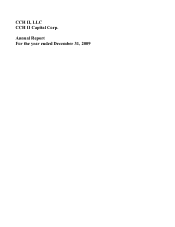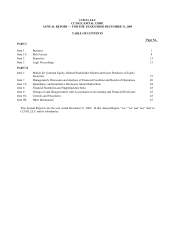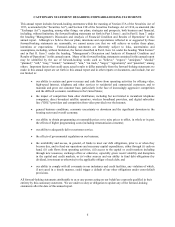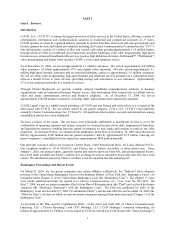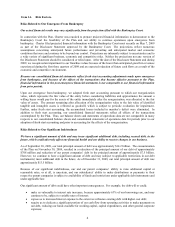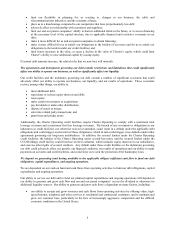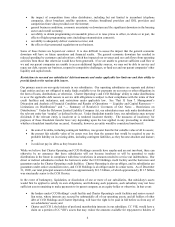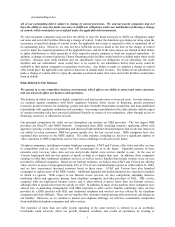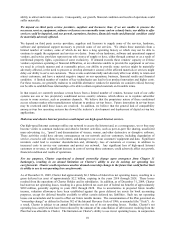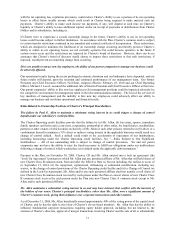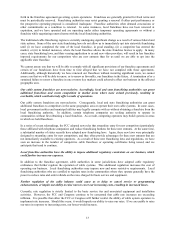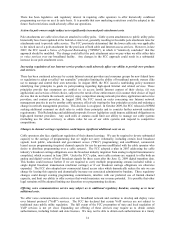Charter 2009 Annual Report Download - page 8
Download and view the complete annual report
Please find page 8 of the 2009 Charter annual report below. You can navigate through the pages in the report by either clicking on the pages listed below, or by using the keyword search tool below to find specific information within the annual report.5
• limit our flexibility in planning for, or reacting to, changes in our business, the cable and
telecommunications industries, and the economy at large;
• place us at a disadvantage compared to our competitors that have proportionately less debt;
• adversely affect our relationship with customers and suppliers;
• limit our and our parent companies’ ability to borrow additional funds in the future, or to access financing
at the necessary level of the capital structure, due to applicable financial and restrictive covenants in our
debt;
• make it more difficult for us and our parent companies to obtain financing;
• make it more difficult for us to satisfy our obligations to the holders of our notes and for us to satisfy our
obligations to the lenders under our credit facilities; and
• limit future increases in the value, or cause a decline in the value of Charter’ s equity, which could limit
Charter’ s ability to raise additional capital by issuing equity.
If current debt amounts increase, the related risks that we now face will intensify.
The agreements and instruments governing our debt contain restrictions and limitations that could significantly
affect our ability to operate our business, as well as significantly affect our liquidity.
Our credit facilities and the indentures governing our debt contain a number of significant covenants that could
adversely affect our ability to operate our business, our liquidity, and our results of operations. These covenants
restrict, among other things, our ability to:
• incur additional debt;
• repurchase or redeem equity interests and debt;
• issue equity;
• make certain investments or acquisitions;
• pay dividends or make other distributions;
• dispose of assets or merge;
• enter into related party transactions; and
• grant liens and pledge assets.
Additionally, the Charter Operating credit facilities require Charter Operating to comply with a maximum total
leverage covenant and a maximum first lien leverage covenant. The breach of any covenants or obligations in our
indentures or credit facilities, not otherwise waived or amended, could result in a default under the applicable debt
obligations and could trigger acceleration of those obligations, which in turn could trigger cross defaults under other
agreements governing our long-term indebtedness. In addition, the secured lenders under the Charter Operating
credit facilities, the holders of the Charter Operating senior second-lien notes, and the secured lenders under the
CCO Holdings credit facility could foreclose on their collateral, which includes equity interests in our subsidiaries,
and exercise other rights of secured creditors. Any default under those credit facilities or the indentures governing
our debt could adversely affect our growth, our financial condition, our results of operations and our ability to make
payments on our notes and credit facilities, and could force us to seek the protection of the bankruptcy laws.
We depend on generating (and having available to the applicable obligor) sufficient cash flow to fund our debt
obligations, capital expenditures, and ongoing operations.
We are dependent on our cash on hand and cash flows from operating activities to fund our debt obligations, capital
expenditures and ongoing operations.
Our ability to service our debt and to fund our planned capital expenditures and ongoing operations will depend on
our ability to generate and grow cash flow and our and our parent companies’ access (by dividend or otherwise) to
additional liquidity sources. Our ability to generate and grow cash flow is dependent on many factors, including:
• our ability to sustain and grow revenues and cash flows from operating activities by offering video, high-
speed Internet, telephone and other services to residential and commercial customers, and to maintain and
grow our customer base, particularly in the face of increasingly aggressive competition and the difficult
economic conditions in the United States;

